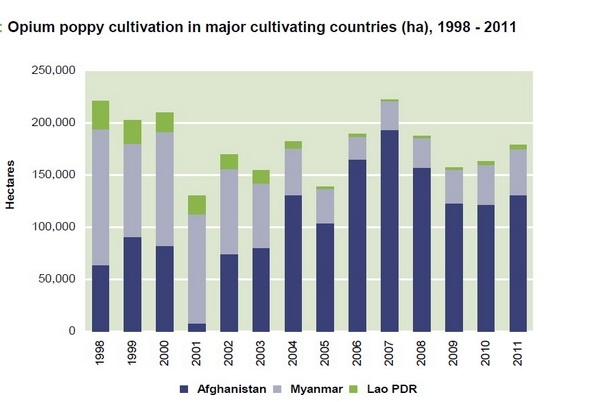
By Souksakhone Vaenkeo, a reporter from Laos, who is on exchange at the EOLast month we wrote about how
China had invested more than 10 billion yuan to encourage farmers in northern Myanmar not to plant opium poppies in an attempt to curb the rise of the opium production on their border, it appears these efforts have been in vain.
According to
a new report from the United Nations Office on Drug and Crime (UNODC), opium cultivation in Myanmar and Laos has increased, with high prices offering farmers a better incentive to plant the illicit crop.
According to the report, despite the efforts of national governments to reduce the planting of opium, the area of opium plantations in Laos increased by 37 percent in 2011, up to 4,100 hectares from last year's 3,000 hectares.
The area of poppy plantations in Myanmar also increased, up 14 percent from 38,100 hectares in 2010 to 43,600 hectares in 2011, according to the
2011 South-East Asia Opium Survey, published by the UNODC in cooperation with various governments in the region.
Cultivation of opium poppies, which is used to produce heroin, rose by 16 percent across the whole Southeast Asia region.
Areas of Laos, Myanmar and Thailand are the main opium cultivation areas in the region, with plantations of 47,917 hectares in 2011, almost double the 24,157 hectares planted in 2006.
Thailand was the only one of the three countries in which the area of poppy cultivation dropped, down to 217 hectares from last years 289 hectares.
The survey also estimated that total opium production in the three countries reached 638 metric tons in 2011, with a total potential value of $319 million, $100 million more than the value of last year's crop from the past year.
Laos saw poppy cultivation drop from 26,800 hectares in 1998 to only 1,800 hectares in 2005, but since then, annual figures have been inconsistent - rising and falling from year to year.
Lao officials attributed the increase to rural poverty, which encouraged farmers to engage in the illicit activities.
Myanmar also witnessed a dramatic decrease in opium poppy cultivation between in 2005 and 2006. However, despite the decrease over those years, the country, which produced about 610 metric tons of opium in 2011, remains the second largest opium producer in the world after Afghanistan, responsible for 23 percent of world opium poppy cultivation in 2011.
Links and SourcesUNDOC: Full Report
